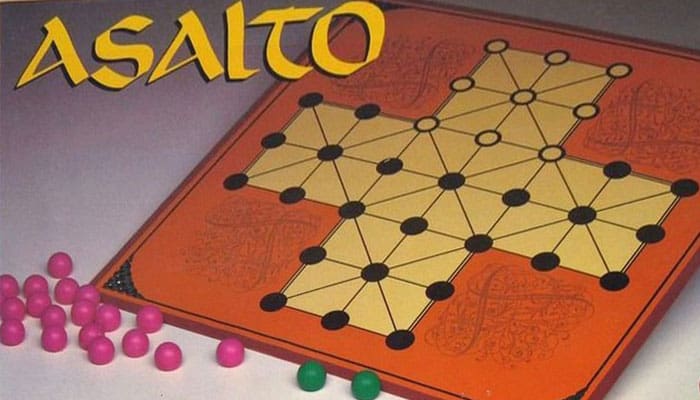
Asalto is a siege game, where a couple of officers face a rebellion by a large number of soldiers. The officers begin the game in a fortress and attempt to defend it and themselves against the rebellious onslaught. The game was based on a medieval game of fox & geese.
Fox & geese pits one fox against a number of geese, but in the seventeenth-century experiments were made by adding a second, and sometimes a third, fox and increasing the number of geese accordingly. By the nineteenth century, these experiments had resulted in the game of Asalto.
The precise origins of asalto are unknown. It is not Spanish, despite its name. The game was popular in Germany, where some variations were made, and in Britain the game was marketed as Officers & Sepoys after the 1857 Indian Mutiny.
The game was also played in France under the name assault. But it is not known which of these games came first.

Components
- Gameboard with a grid of 33 intersection points in the shape of a cross,
- 24 rebel pieces
- 2 officers pieces
- Instructions
Game Play
Asalto is played by two players on a board resembling that used nowadays for solitaire. The differences are that the playing spaces are linked by lines, including some on the diagonals, to indicate allowable directions of
movement. One end of the board is also marked out as the fortress, encompassing nine squares in total. One player has two officers, and the other has twenty-four rebels.
Illustration 1: the Asalto board, with rebels
set out for play. Officers will be placed on
any two points of the fortress.
Beginning the Game
Players decide at random who takes which side. In subsequent games, the players should swap sides. The rebels are placed on the board, filling every space outside the fortress, as shown in Illustration 1.
The two officers are placed anywhere in the fortress, at the discretion of the player who controls them. The rebels make the first move.
Moving the Pieces
Movement and capture are shown in Illustration 2. A rebel may move along a marked line in any direction which does not lead him away from the fortress.

Illustration 2: moves of the pieces.
Officers can move in any direction, but only where a marked line exists (note the lower officer cannot, therefore, move diagonally).
Rebels are subject to the same limitation see rightmost piece), and may not move away from the fortress.
An officer may move in any direction along a marked line, within, away from or towards the fortress. Only one piece may occupy a point at any one time.
Officers cannot leap over each other, and rebels cannot leap at all.

Capturing Enemies
An officer can capture a rebel by leaping over him onto the vacant space beyond. Such a capture must be along a marked line, and the officer cannot turn a corner while leaping.
If the officers' player fails to make a capture when one is available, then the rebel player may point out the capture and remove the officer who failed to make it (called huffing'), before continuing with his own move.
This is the only way an officer can be captured, as the rebels cannot leap.
End of the Game
If the nine points of the fort are occupied by the rebels, they win the game. If the officers are trapped by the rebels so that they are unable to move, they lose the game and the rebels win.
If both the officers are huffed, then they have lost and the rebels win.
If the officers capture so many rebels that their task becomes impossible, then they win the game.
he precise number of rebels needed to win the game varies according to whether one or two officers remain on the board. But if only eight remain on the board, they will be unable to occupy the fortress and so could their cause may be considered lost.
Variation
On some boards, most of the horizontal lines are specially marked, using doubled lines or lines of a different color. This is for the related game German Tactics. Rebels may not move along these specially marked lines, but officers may.

Movement in the German Tactics variation. Note routes along dotted lines may be used only by officers.
The capture of rebels is by the same method as in asalto.
Continue Reading

